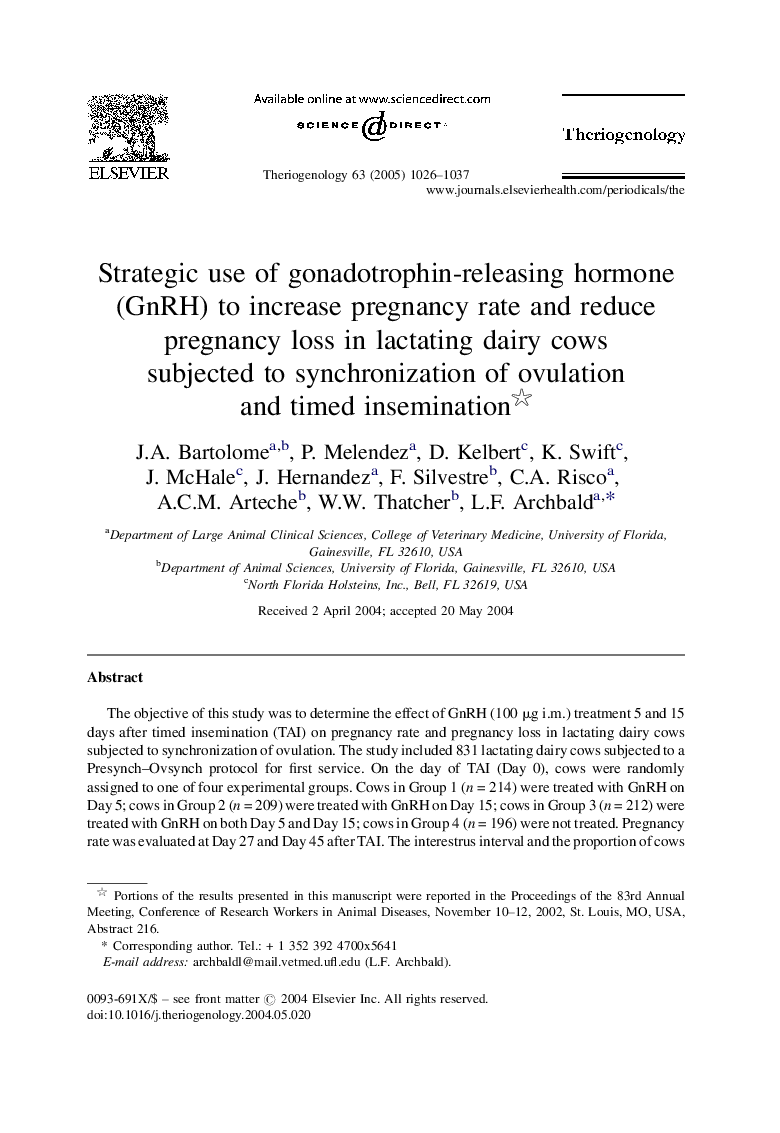| کد مقاله | کد نشریه | سال انتشار | مقاله انگلیسی | نسخه تمام متن |
|---|---|---|---|---|
| 10893291 | 1082195 | 2005 | 12 صفحه PDF | دانلود رایگان |
عنوان انگلیسی مقاله ISI
Strategic use of gonadotrophin-releasing hormone (GnRH) to increase pregnancy rate and reduce pregnancy loss in lactating dairy cows subjected to synchronization of ovulation and timed insemination
دانلود مقاله + سفارش ترجمه
دانلود مقاله ISI انگلیسی
رایگان برای ایرانیان
کلمات کلیدی
موضوعات مرتبط
علوم زیستی و بیوفناوری
علوم کشاورزی و بیولوژیک
علوم دامی و جانورشناسی
پیش نمایش صفحه اول مقاله

چکیده انگلیسی
The objective of this study was to determine the effect of GnRH (100 μg i.m.) treatment 5 and 15 days after timed insemination (TAI) on pregnancy rate and pregnancy loss in lactating dairy cows subjected to synchronization of ovulation. The study included 831 lactating dairy cows subjected to a Presynch-Ovsynch protocol for first service. On the day of TAI (Day 0), cows were randomly assigned to one of four experimental groups. Cows in Group 1 (n = 214) were treated with GnRH on Day 5; cows in Group 2 (n = 209) were treated with GnRH on Day 15; cows in Group 3 (n = 212) were treated with GnRH on both Day 5 and Day 15; cows in Group 4 (n = 196) were not treated. Pregnancy rate was evaluated at Day 27 and Day 45 after TAI. The interestrus interval and the proportion of cows diagnosed not pregnant based on expression of estrus and insemination before pregnancy diagnosis on Day 27 were determined. The results of this study are: (1) GnRH treatment on Day 5 or Day 15 did not increase pregnancy rate, or reduce pregnancy loss between Day 27 and Day 55 after TAI; (2) cows treated with GnRH on both Day 5 and Day 15 had a lower (P < 0.01) proportion of cows diagnosed not pregnant based on expression of estrus before ultrasonography on Day 27 (26.5%) compared to control cows (52.9%), and these cows had an extended (P = 0.05) interestrus interval (23.4 days vs. 21.5 days); and (3) GnRH treatment on both Day 5 and Day 15 after TAI reduced pregnancy rate on Day 27 (36.8% vs. 44.4% for control cows; P < 0.03) and Day 55 (28.3% vs. 36.2% for control cows; P < 0.01). Therefore, strategies to stimulate CL function using multiple doses of GnRH during the luteal phase need to consider potential negative effects.
ناشر
Database: Elsevier - ScienceDirect (ساینس دایرکت)
Journal: Theriogenology - Volume 63, Issue 4, 1 March 2005, Pages 1026-1037
Journal: Theriogenology - Volume 63, Issue 4, 1 March 2005, Pages 1026-1037
نویسندگان
J.A. Bartolome, P. Melendez, D. Kelbert, K. Swift, J. McHale, J. Hernandez, F. Silvestre, C.A. Risco, A.C.M. Arteche, W.W. Thatcher, L.F. Archbald,